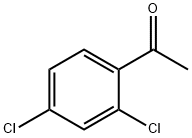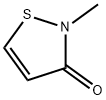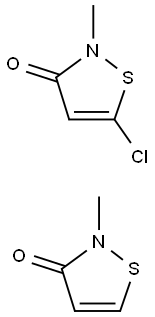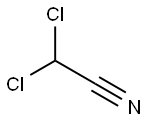4,5-Dichloro-2-octyl-isothiazolone
- CAS NO.:64359-81-5
- Empirical Formula: C11H17Cl2NOS
- Molecular Weight: 282.23
- MDL number: MFCD04034673
- EINECS: 264-843-8
- SAFETY DATA SHEET (SDS)
- Update Date: 2024-12-18 14:08:57

What is 4,5-Dichloro-2-octyl-isothiazolone?
Description
As an irritant and sensitizer, Kathon 930 caused contact dermatitis in employees of a textile finishing factory.
Chemical properties
Dichlorooctylisothiazolinone, DCOIT or DCOI, is an isothiazolinone compound. It is a white solid that melts at room temperature. It is an organic chemical that is slightly volatile and can dissolve in water. The measured K values show that DCOIT tends to move from water to octanol and has moderate to high lipophilicity.
The Uses of 4,5-Dichloro-2-octyl-isothiazolone
Dichloroctylisothiazolinone is used as a broad spectrum biocide. It is used in paints especially marine coatings, decorative wood coatings and plastic industry. It is used primarily as a dry-film mildew protector for paint, coatings, paper, stains, plastics, wood, shoes, adhesives, metalworking fluids and printing inks. It is easily incorporated into water-based or solvent-based formulations.
Definition
ChEBI: 4,5-dichloro-2-n-octyl-3(2H)-isothiazolone(DCOIT) is a 1,2-thiazole that is 1,2-thiazol-3(2H)-one substituted by chloro groups at positions 4 and 5 and an octyl group at position 2. It is used as a fungicide. It has a role as an environmental contaminant, a xenobiotic and a fungicide. It is an organochlorine compound and a member of 1,2-thiazoles.
What are the applications of Application
Suitable for applications in the paints and coatings, wood, and leather fields to resist corrosion and protect against mildews and algae.
Health Hazard
The chemical is referred to as 4,5-dichloro-2-n-octyl-4-isothiazolin-3-one (DCOIT) in this assessment. Where available, data for two commercial antifouling products C-9211 HQ (32.6 % of DCOIT in xylene) and Acticide? DCOIT (97.1% purity) are used for some health end-points. The information on health hazards is primarily obtained from the comprehensive reviews from the Norwegian Environment Agency as part of its ECHA CLH proposal (ECHA, 2018) and an EU (Norway) DCOIT evaluation for the use of DCOIT as a biocide in antifouling products (EU, 2014). Unless otherwise noted, references to individual studies below are taken from these reviews.
Contact allergens
Irritant and sensitizer, Kathon? 930 caused contact dermatitis in employees of a textile fnishing factory.
Toxicology
The chemical, DCOIT is moderately absorbed through skin and moderately absorbed via oral route. It is then extensively distributed to tissues (liver, kidney, stomach and intestine) and metabolised following oral administration. In a study conducted in rats, 81–93 % of orally administered 14C-DCOIT was excreted primarily in the faeces within a 2-day period. Plasma elimination half-life of 14C-DCOIT was 16.1–19.4 hours for males and 20.5–25.0 hours for females. The highest concentration of 14C-DCOIT was found in liver, stomach, intestine and kidney. More than 80 % of the administered dose was eliminated via faeces, 11–18 % was eliminated via urine and less than 2 % of the dose was eliminated through exhaled air. DCOIT metabolised to form six metabolites in the faeces and eight metabolites in the urine. Degradation of DCOIT involves cleavage of the ring and subsequent oxidation of 7–18 % of the administrated dose to N-(n-octyl) malonamic acid (NNOMA, major metabolite), N-(n-octyl)acetamide, N-(n-octyl)oxamic acid and N-(n-octyl)-β-acetyl propionamide. The chemical undergoes subsequent biotransformation involving hydroxylation, dealkylation and acetylation (EU, 2014; ECHA, 2018).
Safety
The chemical and formulations containing the chemical applied to intact rabbit skin produced severe erythema, oedema and scar formation. The exposed areas had effects that were not reversible. Data indicates corrosive effects in the respiratory tract. While no data are available for effects in the eyes, the chemical is deemed to capable of causing severe damage. There is sufficient evidence to warrant hazard classification.
Synthesis
Add 200 g of ethyl acetate and 23.6 g (0.1 mol) of N,N'-dimethyl-3,3'-dithiodipropionamide into a 500ml four-neck flask equipped with a thermometer and a stirrer, stir and mix, and control The reaction temperature was 15° C., 1.8 g of thionyl chloride (15.1 mmol) was added to the four-neck flask, and the mixture was stirred for 10 min.21.3g (0.3mol) of chlorine gas was introduced into the reaction system, the mixture was stirred for 5h to react, and 27.1g of 4,5-Dichloro-2-octyl-isothiazolone was obtained by filtration and separation. The yield was 84.9%.
in vitro
In a bacterial gene mutation test, DCOIT was tested in Salmonella typhimurium strains TA98, TA100, TA1535 and TA1537 up to a maximum concentration of 300 μg/plate with negative responses in all strains with and without metabolic activation (EU, 2014; ECHA, 2018).
in vivo
In two micronucleus assays, DCOIT was tested in CD-1 mice (5-9 mice/sex/dose) at doses up to 325 mg/kg bw/day by gavage. No genotoxicity was reported in both studies (EU, 2014; ECHA, 2018).
Precautions
1. Suitable for use in all marine paints. Can effectively kill many bacteria and mildews like penicillium notatum, basidiomycetes, aspergillus niger, fusarium, and curvularia. Can be added at any production step for use; it is recommended to adopt the concentration of 5 ~ 15% (w/w).2. Operational instruction must be strictly followed. Avoid any contact with the skin. Wear protective clothes, goggles, and rubber gloves in operation. Once any contact with the skin happens, wash the skin immediately with plenty of water and soaps; when it splashes into eyes, wash immediately with plenty of water and buffer solutions.
Properties of 4,5-Dichloro-2-octyl-isothiazolone
| Melting point: | 40.0 to 44.0 °C |
| Boiling point: | 322.6±52.0 °C(Predicted) |
| Density | 1.25±0.1 g/cm3(Predicted) |
| storage temp. | under inert gas (nitrogen or Argon) at 2-8°C |
| solubility | Chloroform (Slightly), Methanol (Slightly) |
| form | Solid |
| pka | -6.09±0.60(Predicted) |
| color | White to Off-White |
| Merck | 14,3070 |
| Stability: | Air Sensitive |
| InChI | InChI=1S/C11H17Cl2NOS/c1-2-3-4-5-6-7-8-14-11(15)9(12)10(13)16-14/h2-8H2,1H3 |
| CAS DataBase Reference | 64359-81-5(CAS DataBase Reference) |
| EPA Substance Registry System | 4,5-Dichloro-2-n-octyl-4-isothiazolin-3-one (64359-81-5) |
Safety information for 4,5-Dichloro-2-octyl-isothiazolone
| Signal word | Warning |
| Pictogram(s) |
 Exclamation Mark Irritant GHS07  Environment GHS09 |
| GHS Hazard Statements |
H315:Skin corrosion/irritation H317:Sensitisation, Skin H319:Serious eye damage/eye irritation H410:Hazardous to the aquatic environment, long-term hazard |
| Precautionary Statement Codes |
P261:Avoid breathing dust/fume/gas/mist/vapours/spray. P264:Wash hands thoroughly after handling. P264:Wash skin thouroughly after handling. P272:Contaminated work clothing should not be allowed out of the workplace. P273:Avoid release to the environment. P280:Wear protective gloves/protective clothing/eye protection/face protection. P391:Collect spillage. Hazardous to the aquatic environment P501:Dispose of contents/container to..… |
Computed Descriptors for 4,5-Dichloro-2-octyl-isothiazolone
| InChIKey | PORQOHRXAJJKGK-UHFFFAOYSA-N |
| SMILES | S1C(Cl)=C(Cl)C(=O)N1CCCCCCCC |
4,5-Dichloro-2-octyl-isothiazolone manufacturer
New Products
Tert-butyl bis(2-chloroethyl)carbamate (S)-3-Aminobutanenitrile hydrochloride N-Boc-D-alaninol N-BOC-D/L-ALANINOL N-octanoyl benzotriazole 3,4-Dibenzyloxybenzaldehyde 4-Hydrazinobenzoic acid 1,1’-CARBONYLDIIMIDAZOLE R-2-BENZYLOXY PROPIONIC ACID 3-NITRO-2-METHYL ANILINE 4-IODO BENZOIC ACID 4-HYDROXY BENZYL ALCOHOL 4-(3-chloropropyl)morpholine phenylhydrazine hydrochloride (2-Hydroxyphenyl)acetonitrile 4-Bromopyrazole 5-BROMO-2CYANO PYRIDINE 5,6-Dimethoxyindanone 5-broMo-2-chloro-N-cyclopentylpyriMidin-4-aMine 4-methoxy-3,5-dinitropyridine 2-(Cyanocyclohexyl)acetic acid 2-aminopropyl benzoate hydrochloride 1-(4-(aminomethyl)benzyl)urea hydrochloride tert-butyl 4- (ureidomethyl)benzylcarbamateRelated products of tetrahydrofuran








You may like
-
 DCOIT 98%View Details
DCOIT 98%View Details
64359-81-5 -
 4,5-Dichloro-2-n-octyl-4-isothiazolin-3-one CAS 64359-81-5View Details
4,5-Dichloro-2-n-octyl-4-isothiazolin-3-one CAS 64359-81-5View Details
64359-81-5 -
 4,5-dichloro-2-octyl-isothiazolone CAS 64359-81-5View Details
4,5-dichloro-2-octyl-isothiazolone CAS 64359-81-5View Details
64359-81-5 -
 (9H-fluoren-9-yl)methyl (2,5-dioxopyrrolidin-1-yl) carbonate 82911-69-1 98.0%View Details
(9H-fluoren-9-yl)methyl (2,5-dioxopyrrolidin-1-yl) carbonate 82911-69-1 98.0%View Details
82911-69-1 -
 13057-17-5 95.0%View Details
13057-17-5 95.0%View Details
13057-17-5 -
 4-bromoaniline 106-40-1 99.0%View Details
4-bromoaniline 106-40-1 99.0%View Details
106-40-1 -
 5-bromo-2-chlorobenzoic acid 99.0%View Details
5-bromo-2-chlorobenzoic acid 99.0%View Details
21739-92-4 -
 15761-38-3 97.0%View Details
15761-38-3 97.0%View Details
15761-38-3